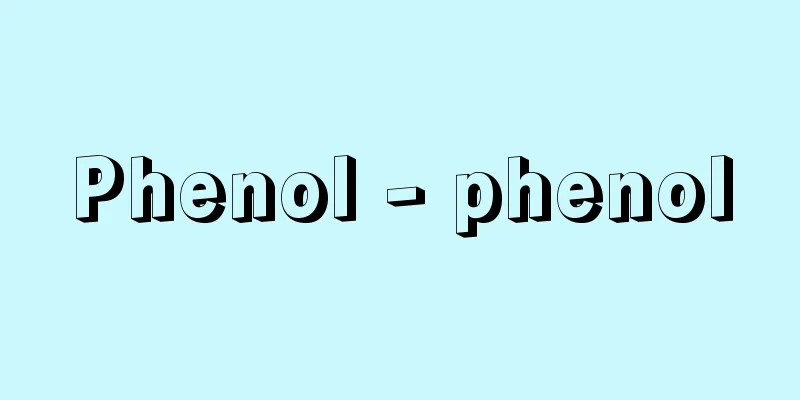Phenol - phenol

|
Compounds in which a hydroxyl group is bonded to an aromatic ring such as benzene are generally called phenols, and are represented by the general formula ArOH (Ar is an aromatic ring such as a benzene ring or a naphthalene ring). The simplest compound, hydroxybenzene, in which one hydrogen atom of benzene is replaced with a hydroxyl group, is called phenol (unless otherwise specified, phenol always refers to phenols). However, compounds in which a hydroxyl group is directly bonded to an aromatic condensed polycyclic hydrocarbon such as naphthalene or phenanthrene are often called naphthol or phenanthrol, respectively. [Tokumaru Katsumi] PhenolsPhenols with one hydroxyl group substituted on the aromatic ring are called monohydric phenols. Phenols with two hydroxyl groups substituted on the aromatic ring, such as catechol, resorcinol, and hydroquinone, are called dihydric phenols, while phenols with three hydroxyl groups substituted on the aromatic ring, such as pyrogallol, are called trihydric phenols. These are collectively called polyhydric phenols. Phenols do not simply have hydroxy groups substituted on the aromatic ring; some compounds have further substitutions such as alkyl groups (e.g., methyl groups) or nitro groups. Examples of such phenols include cresol, nitrophenol, and picric acid. Hydroxybenzene, the simplest compound of phenol, was obtained in 1834 by F. F. Runge of Germany as an acidic substance obtained by distillation of coal tar, and was named carbolic acid (Kohlensäure in German). This compound was then synthesized for the first time from aniline by H. Hunt in 1848. [Tokumaru Katsumi] Manufacturing methodPhenol (hydroxybenzene) was once produced by fractional distillation from coal tar, but with the development of the petrochemical industry, it is now produced mainly from benzene obtained from petroleum. Among them, the method of producing it by converting benzene to benzenesulfonic acid with concentrated sulfuric acid and melting the sodium salt with sodium hydroxide has been used for a long time. In addition, the method called the cumene process, in which benzene is reacted with propylene to produce isopropylbenzene, or cumene, which is oxidized with air to produce its hydroperoxide, and then this is treated with acid to produce phenol and acetone, has become popular due to the petrochemical industry. Other production methods include chlorinating benzene to make chlorobenzene, which is then hydrolyzed with an aqueous sodium hydroxide solution under high temperature and pressure, converting benzene to chlorobenzene using hydrogen chloride and air in the presence of a catalyst, and then further hydrolyzing it with water steam at high temperature, and also oxidizing toluene. [Tokumaru Katsumi] Properties and usesPhenols generally have a much higher boiling point than hydrocarbons whose hydroxyl groups are replaced by hydrogen. Phenols with fewer carbon atoms and polyphenols also dissolve in water to a certain extent. The hydroxyl groups of phenols are acidic, unlike the hydroxyl groups of alcohols, but are generally much less acidic than carboxylic acids such as acetic acid. Many phenols show a unique color reaction when treated with an aqueous solution of iron(III) chloride. For example, phenol (hydroxybenzene) itself is purple, cresol is blue, and salicylic acid is purple. Polyphenols such as hydroquinone are easily oxidized by oxygen in the air, especially in an aqueous alkaline solution. Phenols are generally brominated at the aromatic ring when treated with an aqueous solution of bromine, resulting in a water-insoluble precipitate. It easily undergoes condensation reactions with aldehydes. For example, in the case of phenol (hydroxybenzene) and formaldehyde, if the reaction conditions are selected, two molecules of hydroxybenzene react with one molecule of formaldehyde, eliminating one molecule of water, and giving a compound in which the aromatic rings of the two hydroxybenzenes are condensed with methylene groups. When this reaction is repeated, it produces a high molecular weight phenolic resin. In general, phenols are more reactive to various reagents than compounds in which the hydroxyl group is replaced by hydrogen. For example, they react easily with aromatic diazonium salts to produce azo compounds through coupling reactions. Phenols are highly reactive to radicals, and therefore act as antioxidants in the autoxidation of various organic compounds and polymeric substances, and also inhibit aging caused by oxidation in living organisms. For example, BHT and tocopherol, which are types of phenols, are examples of such antioxidants. Phenol (hydroxybenzene) is used as a raw material for various synthetic resins such as phenolic resin, polycarbonate resin, and epoxy resin, as well as in the pharmaceutical industry, detergents such as nonylphenol, and various dyes. It has a strong bactericidal effect, but care must be taken as it is corrosive if it comes into contact with the skin. [Tokumaru Katsumi] HydroxybenzeneIt is a colorless crystal with a characteristic odor, a phenol in the narrow sense. It is somewhat soluble in water at room temperature, but at temperatures above 65.3°C it mixes with water in any ratio. It also dissolves well in ethanol (ethyl alcohol) and diethyl ether. [Tokumaru Katsumi] PharmaceuticalIt is a germicidal disinfectant. It has a corrosive effect and turns white when it comes into contact with the skin. In addition to phenol, the Japanese Pharmacopoeia lists liquid phenol, disinfectant phenol, phenol water, and disinfectant phenol water. A 1-5% solution is used for disinfection. In addition to disinfection, it is also used as a preservative. It also has a weak numbing effect, so it is used to relieve pain and itching (phenol-zinc oxide liniment). Other preparations include dental phenol-camphor used in dental treatment, iodine-salicylic acid-phenol essence, and compound salicylic acid essence used for tinea infections such as athlete's foot and ringworm. [Fumiji Koho] [References] | | | | | | | | | | | | | | | | | | | | |Disinfectants| | | | | | | | | | | | | | | | | | | |Methyl | | | | | | [Supplementary information] |Source: Shogakukan Encyclopedia Nipponica About Encyclopedia Nipponica Information | Legend |
|
ベンゼンなどの芳香環にヒドロキシ基が結合した化合物を一般にフェノール類といい、ArOHの一般式で表す(Arはベンゼン環、ナフタレン環などの芳香環)。また、そのもっとも簡単な化合物であるヒドロキシベンゼン、すなわちベンゼンの水素原子1個がヒドロキシ基で置換された化合物をフェノールという(以下、とくに断らない限り、フェノールと記すときはつねにフェノール類をさす)。しかし、ナフタレンやフェナントレンのような芳香族縮合多環炭化水素にヒドロキシ基が直接結合した化合物はそれぞれナフトールやフェナントロールのようによばれることが多い。 [徳丸克己] フェノール類芳香環にヒドロキシ基が1個置換したフェノールを一価フェノールという。 カテコール、レゾルシン、ヒドロキノンのように芳香環に2個のヒドロキシ基の置換したフェノールを二価フェノール、また、ピロガロールのように芳香環に3個のヒドロキシ基の置換したフェノールを三価フェノールとよび、これらを総称して多価フェノールという。 フェノールには単にヒドロキシ基が芳香環に置換しているだけでなく、メチル基などのアルキル基やニトロ基などがさらに置換した化合物もあり、クレゾールやニトロフェノール、ピクリン酸などはこのようなフェノールの例である。 フェノールのもっとも簡単な化合物であるヒドロキシベンゼンは、1834年ドイツのF・F・ルンゲによって、石炭を乾留して得られるコールタールから分留された酸性の物質として得られ、石炭酸(ドイツ語でKohlensäure)と名づけられた。その後この化合物は1848年にフントH. Huntによって初めてアニリンから合成された。 [徳丸克己] 製法フェノール(ヒドロキシベンゼン)は、かつてはコールタールから分留によって製造されたが、石油化学工業の発展に伴い、現在はもっぱら石油から得られるベンゼンを原料として製造される。なかでもベンゼンを濃硫酸によりベンゼンスルホン酸とし、そのナトリウム塩を水酸化ナトリウムとともに溶融して製造する方法は古くから行われているものである。また、ベンゼンをプロピレンと反応させてイソプロピルベンゼン、すなわちクメンとし、これを空気酸化してそのヒドロペルオキシドとし、ついでこれを酸で処理してフェノールとアセトンを製造するクメン法とよばれる方法は、石油化学工業により盛んとなったものである。 このほか、ベンゼンを塩素化してクロロベンゼンとし、これを高温高圧下で水酸化ナトリウム水溶液により加水分解する製造法、ベンゼンを触媒存在下塩化水素と空気によりクロロベンゼンとし、さらに高温で水蒸気により加水分解する製造法、またトルエンの酸化による製造法などがある。 [徳丸克己] 性質と用途フェノールは、一般にそのヒドロキシ基が水素で置換された炭化水素に比べて沸点がかなり高い。また、炭素数の少ないフェノールや多価フェノールは、水にもある割合で溶ける。フェノールのヒドロキシ基はアルコールのヒドロキシ基とは異なり酸性を示すが、一般に酢酸などのカルボン酸よりは酸性がはるかに弱い。フェノールの多くは塩化鉄(Ⅲ)水溶液により特有の呈色反応を示す。たとえば、フェノール(ヒドロキシベンゼン)そのものは紫色を、また、クレゾールは青色を、サリチル酸は紫色を呈する。ヒドロキノンなどの多価フェノールはとくにアルカリ水溶液では空気中の酸素により容易に酸化される。フェノールは一般に臭素の水溶液の作用により芳香環が臭素化され水に不溶性の沈殿を生ずる。 アルデヒドとは容易に縮合反応をおこす。たとえば、フェノール(ヒドロキシベンゼン)とホルムアルデヒドでは、反応条件を選ぶと、2分子のヒドロキシベンゼンが1分子のホルムアルデヒドと反応して水1分子が脱離し、2個のヒドロキシベンゼンの芳香環がメチレン基で縮合した化合物を与え、この反応が繰り返されると、高分子量のフェノール樹脂を生ずる。 一般にフェノールは、そのヒドロキシ基が水素で置換された化合物に比べて、種々の試剤に対して反応性が高い。たとえば、芳香族ジアゾニウム塩とは容易に反応して、カップリング反応によりアゾ化合物を生ずる。 フェノールはラジカルに対して反応性が高いので、各種の有機化合物や高分子物質の自動酸化において抗酸化剤として作用し、また生体における酸化による老化を阻害する。たとえば、フェノールの一種であるBHTやトコフェノールは、そのような抗酸化剤の例である。 フェノール(ヒドロキシベンゼン)はフェノール樹脂をはじめポリカーボネート樹脂、エポキシ樹脂などの各種の合成樹脂や医薬品工業の原料、さらにノニルフェノールのような洗剤や各種の染料の原料として利用される。強力な殺菌効果があるが、皮膚につくと腐食性を示すので注意を要する。 [徳丸克己] ヒドロキシベンゼン狭義のフェノールで、特有の臭気をもつ無色の結晶である。常温の水にはいくらか溶けるが、65.3℃以上では水と任意の割合で混ざり合う。またエタノール(エチルアルコール)、ジエチルエーテルなどによく溶ける。 [徳丸克己] 医薬用殺菌消毒薬。腐食作用があり、皮膚につけると白くなる。日本薬局方には、フェノールのほか、液状フェノール、消毒用フェノール、フェノール水、消毒用フェノール水が収載されている。消毒用には1~5%の溶液が用いられる。消毒用のほか、保存剤としても用いられる。また、弱い知覚麻痺(まひ)作用を有するところから、痛み、かゆみを止める目的でも配合される(フェノール・亜鉛華リニメント)。そのほか、製剤には、歯科治療に用いられる歯科用フェノール・カンフルや、水虫、たむしなど白癬(はくせん)菌の感染症に用いられるヨード・サリチル酸・フェノール精、複方サリチル酸精などがある。 [幸保文治] [参照項目] | | | | | | | | | | | | | | | | | | | | | | | | | | | | | | | | | | | | | | | | | | | | | | | [補完資料] |出典 小学館 日本大百科全書(ニッポニカ)日本大百科全書(ニッポニカ)について 情報 | 凡例 |
<<: Phenolic resin - phenolic resin
Recommend
Five Barbarians and Sixteen Kingdoms
The group of nations that rose and fell in northe...
Taishakyo - Taishakyo
〘Noun〙 One of the thirteen Shinto sects. It began ...
Parallel processing - heiretsushori (English spelling)
Some parts of a computer program can be run indepe...
Consumable electrode
When melting and smelting metal materials to produ...
Cymbidium dayanum
…[Ken Inoue] [Haruto Kurosaki]. … From [Shunran (...
Pontryagin, Lev Semënovich
Born: September 3, 1908 in Trubchevsk [Died] May 3...
Tagbilaran
…The entire island, including the islands that ac...
Enlarged tonsils
What is the disease? What is commonly called the ...
Demon Weapon - Kiki
…In China, items that were only modeled on the ou...
Scythian lamb
…The rhizome and the base of the petiole can be c...
Kikoku Residence - Kikoku Residence
(From the trifoliate orange trees planted around i...
Gasteria genus
…All species are small and neat, and can grow ind...
Whirligig beetle
... About 800 species of Gyrinidae have been reco...
Colombo (English spelling)
The capital of Colombo District, located in the so...
Spheniscus mendiculus (English spelling)
… [Hiroyuki Morioka]. … *Some of the terminology ...









